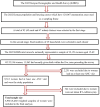Adherence to iron-folic acid supplementation and its associated factors among pregnant women in Kenya: A multilevel data analysis of the 2022 Kenyan Demographic and Health Survey
- PMID: 40748912
- PMCID: PMC12316296
- DOI: 10.1371/journal.pone.0329458
Adherence to iron-folic acid supplementation and its associated factors among pregnant women in Kenya: A multilevel data analysis of the 2022 Kenyan Demographic and Health Survey
Abstract
Background: Iron and folic acid deficiency is a global public health issue, particularly in low- and middle-income countries. Adherence to iron-folic acid supplementation (IFAS) remains low in Kenya. Despite several studies on IFAS adherence in Kenya, they do not assess the national scope and clustering effects using advanced analytical models. Therefore, we aimed to assess IFAS adherence and its associated factors among pregnant women in Kenya using data from the 2022 Kenyan Demographic and Health Survey.
Methods: A secondary data analysis was conducted using data from the 2022 Kenya Demographic and Health Survey, which was obtained from the official Demographic and Health Survey program database. Weighted samples of 8,460 participants were used in the analysis. The study employed a multivariable multilevel mixed-effects logistic regression model. Variables from the bi-variable model that had p < 0.25 were considered in the multivariable analysis. Variables with a p-value < 0.05 were considered statistically significant in the multivariable model, and the adjusted Odds Ratio (aOR) with its 95% CI was reported.
Results: The prevalence of IFAS among pregnant women in Kenya was 61.72% (95% CI: 60.68, 62.75). Women aged 20-39 years were 1.3 to 1.7 times more likely to adhere to IFAS during pregnancy, with the likelihood increasing steadily by age group. Moreover, primigravida [aOR = 1.22 (95% CI: 1.06, 1.41)], with a family size of ≥ 10 [aOR = 0.72 (95% CI 0.59, 0.90)], antenatal care visits ≥ 4 [aOR = 3.96 (95% CI: 1.91, 8.23)], first start of antenatal care at the third trimester of pregnancy [aOR = 0.30 (95% CI: 0.15, 0.62)], and with a higher level of education [aOR = 1.6 (95% CI: 1.35, 1.90)] were statistically significant factors associated with adherence to IFAS.
Conclusion and recommendation: Nearly two in five pregnant women didn't receive IFAS for the recommended periods. Factors such as maternal age, parity, antenatal visits, and education enhanced IFAS adherence, whereas large family size and starting antenatal care in the third trimester of pregnancy reduced adherence. Therefore, the community, government, and non-governmental organizations should enhance adherence by implementing customized interventions on the factors identified as positive and negative associations.
Copyright: © 2025 Alemu et al. This is an open access article distributed under the terms of the Creative Commons Attribution License, which permits unrestricted use, distribution, and reproduction in any medium, provided the original author and source are credited.
Conflict of interest statement
The authors have declared that no competing interests exist.
Figures
Similar articles
-
Adherence to Iron and Folic Acid Supplementation and its determinants among pregnant women in East Africa: Analysis of Demographic and Health Surveys data from nine East African countries.PLoS One. 2025 Jul 16;20(7):e0327410. doi: 10.1371/journal.pone.0327410. eCollection 2025. PLoS One. 2025. PMID: 40668816 Free PMC article.
-
Effect of nutrition education and iron-folic acid supplementation on anemia among pregnant women in Ethiopia: a quasi-experimental study.Sci Rep. 2025 Jan 28;15(1):3556. doi: 10.1038/s41598-025-87957-x. Sci Rep. 2025. PMID: 39875544 Free PMC article.
-
Intermittent oral iron supplementation during pregnancy.Cochrane Database Syst Rev. 2015 Oct 19;2015(10):CD009997. doi: 10.1002/14651858.CD009997.pub2. Cochrane Database Syst Rev. 2015. PMID: 26482110 Free PMC article.
-
Multiple-micronutrient supplementation for women during pregnancy.Cochrane Database Syst Rev. 2017 Apr 13;4(4):CD004905. doi: 10.1002/14651858.CD004905.pub5. Cochrane Database Syst Rev. 2017. Update in: Cochrane Database Syst Rev. 2019 Mar 14;3:CD004905. doi: 10.1002/14651858.CD004905.pub6. PMID: 28407219 Free PMC article. Updated.
-
Multiple-micronutrient supplementation for women during pregnancy.Cochrane Database Syst Rev. 2015 Nov 1;2015(11):CD004905. doi: 10.1002/14651858.CD004905.pub4. Cochrane Database Syst Rev. 2015. Update in: Cochrane Database Syst Rev. 2017 Apr 13;4:CD004905. doi: 10.1002/14651858.CD004905.pub5. PMID: 26522344 Free PMC article. Updated.
References
-
- Bahati F. Determinants of adherence to iron-folic acid supplementation during pregnancy among mothers seeking maternal and child healthcare 0-6 months post-delivery at Kakamega County Referral Hospital: JKUAT-COHES. 2022.
-
- World Health Organization. Worldwide prevalence of anaemia 1993-2005: WHO global database on anaemia. 2008.
-
- World Health Organization. Developing and validating an iron and folic acid supplementation indicator for tracking progress towards global nutrition monitoring framework targets. 2018. Available from: https://iris.who.int/bitstream/handle/10665/274372/9789241514637-eng.pdf...
MeSH terms
Substances
LinkOut - more resources
Full Text Sources
Medical



